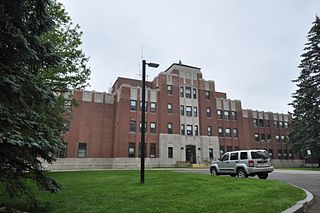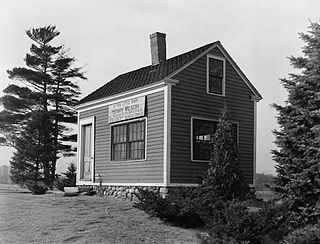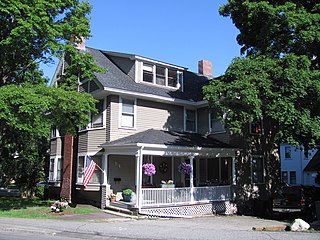
Togus, formally known as the Togus VA Medical Center, is a facility operated by the United States Department of Veterans Affairs in Chelsea, Maine. The facility was built as a resort hotel, and housed Union veterans of the American Civil War prior to being converted to a veterans hospital. It was the first veterans facility developed by the United States government.

The Shoe Shop–Doucette Ten Footer is a historic wooden building at 36 William Street in Stoneham, Massachusetts, in the United States. On April, 1984, it was listed in the National Register of Historic Places. The building sits at the back of the Stoneham Historical Society premises.

The Henry Wilson Shoe Shop is an historic "ten footer" building located at 181 West Central Street, Route 135 in Natick, Massachusetts, USA. Built in the 1850s, it was the shoe shop of Henry Wilson, a Senator from Massachusetts and the eighteenth Vice President of the United States. On July 24, 2000, it was listed in the National Register of Historic Places.

The Haverhill Historical Society Historic District encompasses a collection of historic buildings that have been accumulated by the Haverhill Historical Society at 240 Water Street in Haverhill, Massachusetts. The district, which was listed on the National Register of Historic Places in 2005, has at its core a Federal style farmhouse that was donated to the society in 1903. It includes about 1.5 acres (0.61 ha) of land between John Ward Avenue and the Merrimack River, on which stand four buildings; there is also an archeological site, the remains of a late 17th-century homesite, on the property.

The Brande House is a historic house in Reading, Massachusetts. Built in 1895, the house is a distinctive local example of a Queen Anne Victorian with Shingle and Stick style features. It was listed on the National Register of Historic Places in 1984.

Dewey Place is a historic house in Reading, Massachusetts. The 2+1⁄2-story wood-frame house was built c. 1853 by John Mansfield, a shoe manufacturer, in what was then a popular upper-class neighborhood of the town. The house as classic Italianate design, with three bays across the front and a cupola. The front porch appears to be a 20th-century alteration. The house's most prominent owner was Francis O. Dewey, a major dealer in glass lantern globes.

The Edwin Bassett House is a historic house in Reading, Massachusetts. It is a well-preserved Greek Revival house, built in 1850 by Edwin Bassett, the first Reading shoemaker to install a McKay stitching machine, a device that revolutionized and led to the industrialization of what was before that a cottage industry. The house was listed on the National Register of Historic Places in 1984.

The Ephraim Weston House is a historic house in Reading, Massachusetts. It is incorrectly listed on the National Register of Historic Places as the Ephrain Weston House, at 224 West Street. It was built in the early years of the 19th century by Ephraim Weston, a local real estate developer and businessman; he operated a local general store and a shoe manufacturing business, one of the early such businesses in the town. It is a two-story wood-frame structure, with a hip roof and two chimneys. The main facade faces south, and has a single-story porch extending across its width, supported by square posts. The building corners are pilastered, and a single-story bay projects from the west side. The house is locally distinctive as a rare Federal period house with a hip roof and later applied Italianate styling.

The Gilman Coggin House is a historic house in Reading, Massachusetts. The 2+1⁄2-story wood-frame house is a fine well preserved local example of Greek Revival architecture. It was built in 1847 by Gilman Coggin, owner of a local shoe-manufacturing business. The house's front gable is fully pedimented, supported by wide corner pilasters. A single-story wraparound porch has square Ionic columns, and the front door surround is flanked by half-length sidelight windows and topped by a fanlight transom.

206 West Street is historic house located in Reading, Massachusetts. It is locally significant as a well-preserved example of a Greek Revival cottage.

The House at 42 Salem Street in Reading, Massachusetts is a transitional Greek Revival-Italianate house. Built sometime before 1854, its gable end faces the street, with the door on the left bay of three, a typical Greek Revival side hall layout. The doorway is topped by a heavy Italianate hood. The windows have shallow pedimented lintels, and the left facade has a projecting square bay. The house was occupied for many years by S. H. Dinsmore, a cabinetmaker who originally worked from a shop in the rear of the property and later moved to a larger space a short way down Salem Street. The house is typical of small industry that developed along Salem Street in the second half of the 19th century. It is next door to the Washington Damon House.

The House at 44 Temple Street in Reading, Massachusetts is an excellent local example of the Bungalow style of architecture. Built c. 1910, it has a low hip roof with exceptionally wide eaves supported by exposed rafters. The front of the roof is further supported by two large decorative knee braces. Large square shingled piers anchor the balustrade of the front porch. One of its early owners, Annie Bliss, wrote a column in the local Reading Chronicle, and ran a candy shop out of her home.

The James Nichols House is a historic house in Reading, Massachusetts. Built c. 1795, this 1+1⁄2-story gambrel-roofed house is built in a vernacular Georgian style, and is a rare local example of the style. The house was built by a local shoemaker and farmer who was involved in a religious dispute that divided the town. The house was listed on the National Register of Historic Places in 1984.

The Joseph Bancroft House is a historic house in Reading, Massachusetts. Built in the early 1830s, it is a prominent local example of Federal period architecture. It was built for a member of the locally prominent Bancroft family, who inherited a large tract of land in the area. The house was listed on the National Register of Historic Places in 1984.

The Pratt House is a historic house in Reading, Massachusetts. The two-story wood-frame house built in 1809 and is stylistically a transitional Georgian/Federal structure. The main portion of the house is a single room deep, and there is a two-story shed-roof extension on the rear. The house belonged to various members of the locally prominent Pratt family, including Joseph Pratt, the first Reading shoe manufacturer to use a stitching machine.

The Stillman Parker House is a historic house at 484 Summer Avenue in Reading, Massachusetts. Probably built in the 1850s, it is a rare local variant of transitional Federal/Greek Revival styling. The 1+1⁄2-story wood-frame house has a high-pitched roof which extends over the front porch, which is supported by fluted Doric columns. The doors and windows have Greek Revival architrave surrounds. The house belonged to Stillman Parker, a local shoe manufacturer who also served on the town's board of selectmen.

The Lewis House is a historic house at 276 Woburn Street in Reading, Massachusetts. The 2+1⁄2-story wood-frame house was built in the late 1870s by John Lewis, a successful shoe dealer. The house is three bays wide, with a hipped roof with a single gable dormer. The roof has extended eaves with false rafter ends that are actually lengthened modillion blocks; these features give the house a Colonial Revival feel. The corner boards are pilastered, and the front entry is flanked by half-length sidelight windows and topped by a pedimented lintel, above which is a round fanlight window.

The Blake Daniels Cottage is a historic house at 111–113 Elm Street in Stoneham, Massachusetts. Built in 1860, it is a good example of a Greek Revival worker's residence, with an older wing that may have housed the manufactory of shoe lasts. The house was listed on the National Register of Historic Places in 1984.

The Locke–Baldwin–Kinsley House is a historic house at 45 Green Street in Stoneham, Massachusetts, United States. The two-story timber-frame house was built c. 1744 on land belonging to the Locke family. It has two slender interior chimneys, and an ell on the south side that has documented use as a shoe shop its early 19th-century owners. The house was later (1867) owned by Micah Baldwin, a harness maker, and has remained in the hands of his descendants.

The House at 113 Salem Street in Wakefield, Massachusetts is a rare well-preserved example of a 19th-century shoemaker's shop. The 1+1⁄2-story wood-frame house was built in the 1840s or 1850s, and was originally the shoe shop of David Nichols, who lived at 103 Salem Street. Its early form, with the high-pitch, gable roof, is readily recognizable despite later alterations and additions. These types of buildings were once common in the town, where shoemaking was a home-based cottage industry.























